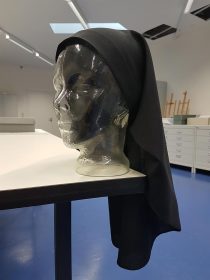A Visit with Sister Katharina at Karmel Berlin

Sister Katharina donated this veil to us for our exhibition; Jewish Museum Berlin, photo: Katharina Erbe.
Covering one’s head has almost entirely disappeared from Christian women’s devotional practice. In Germany, you only actually see veils on the sisters of Catholic religious orders. In preparing for the exhibition Cherchez la femme (more about it on our website) we all agreed early on that we wanted a nun’s veil.
So I set out for Karmel Regina Martyrum in the northern part of Berlin’s Charlottenburg district, a convent of Discalced (or Barefoot) Carmelites. The convent’s wardrobe mistress, Sister Katharina, greeted me at the door. After some discussion, her view on the matter emerged as fairly sober: some people may ascribe specific spiritual meaning to certain items of clothing but it was very personal issue. In any one community you can meet with a wide variety of attitudes and practices.
Our conversation about the meaning of their religious dress began with Sister Katharina sharing an anecdote: some time ago she got to talking with a young Muslim woman who believed that “faith isn’t something you can see from the outside.” She liked this statement because it points to how she and her community live their deepest principles honestly. Ultimately, everything else is formalities.

The Church of Maria Regina Martyrum in the northern part of Berlin’s Charlottenburg district; photo: Rabanus Flavus, via Wikimedia Commons
The clothing regulations come from the Carmelites’ monastic rules, which were drafted in the 16th century by Saint Teresa of Ávila. The veil isn’t mentioned, since at that time women never went out into the street bareheaded anyway. What Teresa stipulated was a brown woolen dress and “scapular,” a kind of apron fitted over the dress. The color brown was a result of the color of Spanish sheep, and in order not to use too much cloth, the sleeves weren’t to be too wide. In addition they were to wear hemp sandals, thus the name “discalced” from the Latin for “without shoes.”
These regulations are closely intertwined with other reformations Teresa proposed: she wanted to simplify life in the order and renounce worldly possessions, as the commands to save cloth and use un-dyed wool express. Today, instead of pure wool, Sister Katharina uses a wool-synthetic blend, which is significantly less expensive and lower maintenance. The hemp sandals have yielded to leather sandals, with soles that can withstand city pavements.
Pace pragmatism, their garb is more than just a simple nod to Saint Teresa. As a sister, one commits to celibacy, poverty, and obedience. For Sister Katharina, poverty means leading a modest, non-materialist life. Life in the order, as she sees it, renders irrelevant the kind of class differences that often become visible through individual sartorial choices. In everyday life, the imperative of obedience means blending in to the community — a principle that their habit reinforces. And there’s yet another function: the religious habit makes them visible and encourages people to talk to them about faith, personal troubles, or other life questions. This visibility doesn’t hold a missionary purpose so much as an open, if unintentional, offer to talk, exchange views, and perform pastoral care. And lastly, the veil, Sister Katharina explains, is a sign of belonging to God.
We were still deep in conversation when the bells rang, calling her to prayer. Sister Katharina invited me to accompany her. I hadn’t done anything like this since I attended Catholic high school, but I agreed. After a brief moment of silence and concentration, I returned, full of joyful drive, to face the day.
Katharina Erbe thinks back fondly on this unexpected and lovely encounter.